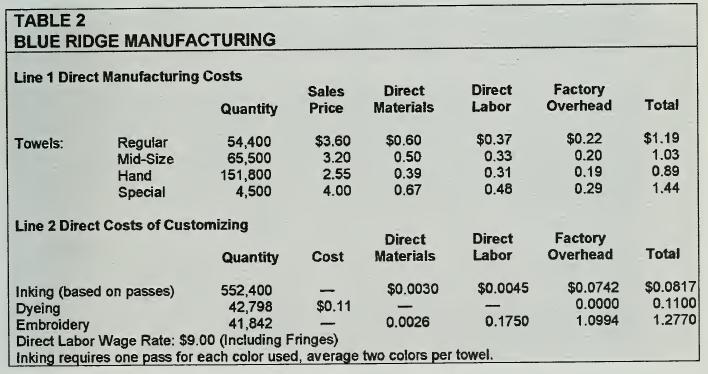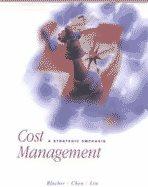BACKGROUND: Blue Ridge Manufacturing produces and sells towels for the U.S. sports towel market. A sports towel
Question:
BACKGROUND:
Blue Ridge Manufacturing produces and sells towels for the U.S. "sports towel" market. A
"sports towel" is a towel that has the promotion of an event or a logo printed on it. They're called sports towels because their most popular use is for distribution in connection with major sporting events such as the Super Bowl, NCAA Final Four, Augusta National Golf Tournament and the U.S. Open Tennis Tournament. Towels with college, NBA and NFL team logos, and promotions for commercial products such as soft drinks, beer, fast food chains, etc., are also big sellers.
The firm designs, knits, prints and embroiders towels. The firm knits all the towels it sells and tracks costs for towel production separately from the cost to customize the towels.
Seventy-five percent of its orders include logo design, while the balance are print only and require the payment of a license fee for the logo used. However, about 15% of its orders include embroidery. Towels are made in three sizes: regular (18" x 30"), hand (12" x 20")
and mid-range (15"x 24"). The normal production cycle for an order of white towels is three days. If a customer wants a colored towel, the basic white towel made by Blue Ridge is sent to a dyeing firm, which extends the production cycle of an order by three days. Also, occasionally, customers order towels in sizes other than the three standard sizes. These towels are called "special".
The firm now produces a "medium" quality towel. They have had some difficulty with the "staying power" of the material printed on these towels, which is attributed to the towel quality, the ink and the printing process. Customers have complained that the ink "lays on the surface" and it cracks and peels off.
Blue Ridge recently made a break-through in developing an ink that soaks into the towel, won't wash out and is non-toxic. A big advantage of this ink is that it avoids EPA disposal requirements because it can be "washed down the drain". Due to these characteristics of its new ink. Blue Ridge is considering upgrading the quality of the basic towel it produces because it will 'lake" the ink better, both the towel and the ink will last longer and the product will sell at a higher price. If it takes this step, the company will evaluate expanding its marketing and sales area with the objective of "going national".
CUSTOMERS:
Except for a few non-regional chains. Blue Ridge's sales are predominantly in the southeastern states. The company sells its products to 986 different customers. These customers differ primarily in the volume of their purchases, so management classifies each customer in one of three groups: large (8), medium (154) and small (824). Large customers are primarily national chains, small customers are single store operations (including pro shops at golf courses) and medium-sized customers are small chains, large single stores or licensing agents for professional sports teams and manufacturers of consumer products.
T-1 gives the product and customer size statistics for 19X2.
Blue Ridge has a different approach to customers in each of its three categories. A small group of in-house sales people sell directly to buyers in the large customer category.
Independent manufacturer representatives, on commission, call on the license holder or the manager of a store in the medium customer category. Ads placed in regional and national magazines and newspapers target customers primarily in the small-customer segment, who call or mail in their orders.
Blue Ridge does not give discounts and it ships all orders FOB point of origin.
MANUFACTURING:
Blue Ridge has a modem knitting and printing plant in the foothills of North Carolina's Blue Ridge Mountains. Upgrading the facilities over recent years was accompanied by the Introduction of an ABC system to determine product costs. The cost accounting system is fairly sophisticated and management has confidence in the accuracy of the manufacturing cost figures for each product line. T-2 shows the firm's unit costs for various items.
Company management is committed to adopting advanced manufacturing techniques such as benchmarking and just-in-time (JIT). The corporate culture necessary for the success of such techniques is evolving and worker empowerment is already a major program. In addition, workers are allowed several hours away from regular work assignments each week for training programs conferring on budgets and work improvements and applying the ABC system.
PERFORMANCE:
The income statement in T-3 shows that the company is profitable. However, management has become concerned about the profitability of the customers in its three customer-size categories—large, medium and small. Different customers demand different levels of support. Management has no basis for identifying customers that generate high profits or to drop those that do not generate enough revenues to cover the expenses to support them.
Under the previous accounting system, it wasn't possible to determine the costs of supporting individual customers.
With the introduction of ABC, it now may be possible to determine customer profitability.
T-4a shows how the administrative and selling costs are assigned and re-assigned between various functions within the selling and marketing areas and to sub-activities in the selling and marketing areas. T-4b provides a list of selling and marketing activities and the activity base to use in assigning costs to each.
Required:
The managers of Blue Ridge Manufacturing have hired your consulting finn to advise them on the potential of using strategic cost analysis in assessing the profitability of their customer accounts.
Your analysis should include:
1 .
What is Blue Ridge's competitive strategy?
2. What type of cost system does Blue Ridge use, and is it consistent with their strategy?
3. Develop a spreadsheet analysis which can be used to assess the profitability of the three customer groups of Blue Ridge—large, medium and small customer account sizes. Use the information in Tables 1-4 to trace and allocate the costs necessary for the analysis.






Step by Step Answer:

Cost Management A Strategic Emphasis
ISBN: 9780070059160
1st Edition
Authors: Edward Blocher, Kung Chen, Thomas Lin





